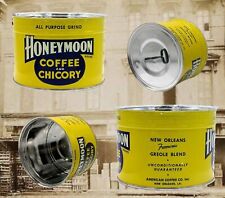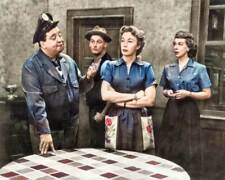|

On eBay Now...
Rare HONEYMOON COFFEE & CHICORY NEW ORLEANS 1 Lb. ADVERTISING TIN ~ CREOLE BLEND For Sale

When you click on links to various merchants on this site and make a purchase, this can result in this site earning a commission. Affiliate programs and affiliations include, but are not limited to, the eBay Partner Network.

Rare HONEYMOON COFFEE & CHICORY NEW ORLEANS 1 Lb. ADVERTISING TIN ~ CREOLE BLEND:
$15.00
Rare HONEYMOON COFFEE & CHICORY NEW ORLEANS 1 Lb. ADVERTISING TIN ~ CREOLE MONTH, WE ARE PLEASED TO OFFER MANY FINE ANTIQUE AND ARTIFACTS AND RARITIES FROM MISSISSIPPI AND LOUISIANA ESTATES AND PRIVATE COLLECTIONS
PLEASE CHECK OUR OTHER items FOR MORE EXAMPLES OF EARLY ANTIQUES & RARE EXAMPLE, QUITE HARD TO FIND, MEASURES 5\" IN DIAMETER AND 3.5\" TALL, BEING A 1 POUND VACUUM PACK STYLE TIN, APPEARING TO HAVE NEVER BEEN SEALED, WITH A SHARP TOP RIM FLANGE.
A BILLBOARD ADVERTISING STYLE LOGO IN DEEP BROWN, READS HONEYMOON Brand COFFEE AND CHICORY REPEATED ON THE FRONT AND REAR.
OTHER LETTERING READS NEW ORLEANS FAMOUS CREOLE BLEND ~ UNCONDITIONALLY GUARANTEED ~ AMERICAN COFFEE CO., INC. ~ NEW ORLEANS, LA. ALONG WITH ALL PURPOSE GRIND ~ VACUUM PACKED ~ ONE POUND NET. LETTERING.
ON THE UNDERSIDE, THE KEY OPENER IS AFFIXED AND INTACT.
MINOR MINOR ELEMENTS RELATIVE TO AGE, HANDLING ADN MATERIAL ~ OVERALL FINE, VINTAGE CONDITION, BEING A LITTLE DUSTY AND DIRTY, AS ACQUIRED AND STORE FOR DECADES ~ CONDITION BEST NOTED BY EXAMINING THE IMAGES OFFERED.
History ~ The AMERICAN COFFEE COMPANY of NEW ORLEANS, LOUISIANA
The American Coffee Company, founded in 1890, began its operations in New Orleans at 423 South Peters Street. Its first offering was the French Market Coffee brand. Over the years, American\'s brands expanded to include St. Charles, Honeymoon, French Opera, Tulane, Pointer, Dixieland, Loyola, and Monteleone. The company solidified its presence in regional stores after acquiring the New Orleans Coffee Company in 1934 and Merchants Coffee in 1950.
Until recently, the company roasted popular brands like Union and French Market Coffee on-site at its 800 Magazine Street location. It also supplied commercial-grade coffee to local restaurants and businesses under the Alameda label. Roasting operations at the Magazine Street location have ceased, and the company has closed its doors, selling its remaining brand names. While some brands continue to be offered under their original names, they are now distributed by a new company. Peche Seafood Grill now occupies the old New Orleans Coffee Company building.
HISTORY OF COFFEE TINS
There are many categories of coffee tins that exist: pre-1901 two color, decorated metal box variety, paper label over tin or cardboard, key or strip open types, pail, coffee bins and the tall cylindrical lithographed tin one-pound containers.
The lithographed one-pound tin was introduced on the 1880s although coffee had been packed in tin since the early 1800s. The labels on these early tins were either soldered embossed or stenciled. Pre-1901 the tins were not of uniform size. They were square, cylindrical, rectangular or box-shaped with a small pull-off or hinged lid. 1901 was the year that most of the early lithographic companies were bought out by the American Can Company. The pre-1901 tin will usually have the tin makers name on the label. There were only two colors in the lithography process, usually black with either red, green, yellow or blue, or a shade of one of these colors. By 1914, multicolored tins began to be mass produced using techniques of chromatography. Since the containers could sell the coffee the more exquisite the label the better the product would sell.
The 1920s brought about keen competition for the coffee seller and a variety of different sized containers became available. It is known that at least 350 different brands in tall, lithographed one-pound tins existed and 1,100 short key-open tins. As the hobby grows more unknown tins pop up. Paper label containers probably exist in even greater numbers. Many of the multi-colored paper labels are just as exquisitely detailed if not even more so than tin and much less expensive in todays market. The tall one pound containers have two basic types of lids: the pry-off type which is inset in the top about 1/4 inch from the edge the twist-off which fits over the top and twists down. These lids were introduced with the start of air-tight coffee containers after the turn of the century. This type of container allowed the coffee to stay fresh longer.
In the late 1920s the key-open tin was introduced and a true vacuum seal was created. The tall one-pound tin disappeared in the art Deco Period of the early 30s and was totally replaced by the key-open tins and glass containers and in some cases paper bags. Tins are still showing up but with less and less regularity.
HISTORY OF NEW ORLEANS COFFEE, CHICORY & CREOLE BLENDS
As with other tropical commodities, coffee did not become widelyavailable outside of wealthier domains until the establishment of slavepoweredcoffee plantations in the Americas. The French establishedtheir plantations in the West Indies during the late 1600s and early1700s. Successfully cultivated in Martinique about 1720, coffee wasbrought by the French to their new colonies. This included NewOrleans, founded only two years before. Haiti soon followed and, fromthe 1730s until the slave uprising in 1791, it supplied fifty percent ofthe worlds coffee and forty percent of its sugar.
After all that tea unpleasantness in Boston Harbor, and his visits toFrance, Thomas Jefferson called coffee the favorite drink of thecivilized world. By 1815, the word caf was beginning to replacecoffeehouse, in large part due to the young nations acquisition of NewOrleans with the Jeffersons Louisiana Purchase. So what broughtabout the New Orleans famous pairing of coffee with chicory?Chicory grows in Europe and North America as a wild perennial plantwith blue, lavender, or some times white flowers. In the United Statesand France it is known as curly endive (Chicorium endivia). Endivesare used for salad, but it is the chicory root that is used as a coffeeadditive.
The chicory plant has been cited in the earliest recorded literature.Horace touts it as a major component of his diet when he writes, Mepascant olivae, me chicorea, me malvae (As for me, olives, endivesand mallows provide sustenance). But how New Orleanians came todrink chicory with their coffee had much more to do with AdmiralHoratio Nelson and Union General-in-Chief Winfield Scott.Lord Nelsons dominance of the sea during the Napoleonic warsimpeded the importation of coffee into France, so chicory oftenappeared as either a coffee substitute or an adulterant. The samething happened in the Crescent City during the Civil War. The Unionblockade of the port of New Orleans (implemented as part of GeneralScotts Anaconda Plan) led to the sudden scarcity of coffee and othercommodities. So just as the French did, New Orleanians addedground, roasted chicory root to stretch their limited stock of importedcoffee. The chicory, grown locally as a wartime measure, moved from the realm of temporary fix due to scarcity to the embracing of thechicory blend on a permanent basis. Its smooth texture andcomforting caramel-like flavoring helped coffee with chicory becomeand continue to be a local favorite. The New Orleans City Guidecompiled by the Federal Writers Project of the WPA informs us thatCreole coffee is a mixture of pure coffee and about twenty per centchicory.
Coffee has always been serious business in New Orleans, being amajor port for Latin American trade. But besides the stacks of sackson the port docks, locals have always enjoyed this stimulating brew.Coffee shops are not just a modern phenomenon in this Starbucksage. Even in the decade before the Civil War, there were over 500coffeehouses in the city.
Today, it is estimated that one-third of all coffee imported into NorthAmerica makes a stop through the port of New Orleans. FolgersCoffee (now a division of jelly giant, the J. M. Smucker Company)operates the worlds largest coffee roasting plant a few miles down theMississippi from the French Quarter. Some dozen local roasters,including Folgers, import an average 250,000 to 300,000 tons ofcoffee beans annually through the port. So important is coffee to NewOrleans, President Bush visited Folgers plant in September 2005 rightafter Katrina. Folgers had sales in 2007 totaling $1.6 billion. Localroasters prepare products for some twenty local and national brands.Many like their coffee black (like the young girl in Airplane), but Cafau lait is an immensely popular New Orleans favorite. This custombegan in Vienna when the military obtained huge quantities of beansfrom the defeated Turkish army and then set up shop. Adding milkand sugar to coffee is believed to have originated with a Polish-bornarmy officer named Franciszek Kulczycki, who opened the firstViennese coffee establishment.
CafDu Monde (CDM) coffee (since 1862) is traditionally served au lait(mixed with half coffee and half hot milk) and beignets. One can evenget mocha added there now. William B. Reilly founded the companythat produces CDM Coffee, believing New Orleans would be an idealplace to set up a coffee roasting and grinding business. The companythat began in 1902 now produces not only coffee, but a vast array ofproducts.
Morning Call was the other great French Quarter coffee stand on Decatur, where debs and dates or parents, with kids in their pajamas, could drive up for beignets and coffee. Founded by Joseph Jurisich in1870, it moved to Jefferson Parish in 1974.
Community Dark Roast Coffee, owned by the Saurage family, ispopular with New Orleanians, and today there are CCs throughout thecity. From 1957 to 1961, Jim Henson made lightning-fast humoroustelevision commercials with his muppet-like characters for Communityand other coffee companies. They were a huge success and bolsteredhis career.
In 1890, French Market Coffee & Chicory was first roasted, blendedand packaged in New Orleans. A century ago, there were sometwenty-four coffee dealers in the city, including Merchants CoffeeCompany. Merchants merged in 1986 into the American CoffeeCompany (at 800 Magazine Street since 1941), which produces FrenchMarket and Union Coffee. New Orleans author and food critic TomFitzmorris recommends Union Coffee and Chicory as his preference.There are so many favorite coffee brands and shops in the NewOrleans area. Phyllis Jordan opened the first PJs on Maple Street in1978 and others followed. Theres Rue de la Course, Royal Blend,Croissant dOr, CafBeignet, VooBrew and Nola Beans, to name just USE THE \"CONTACT SELLER\" FUNCTION TO CONTACT US AND RESOLVE ANY QUESTIONS BEFORE offerDING PLEASE USE THE SHIPPING CALCULATOR TO DETERMINE FIRST CLASS PARCEL SHIPPING RATESINTERNATIONAL SHIPPING AVAILABLE BY PRIORITY MAIL INTERNATIONAL ONLY ~ CONTACT US FOR A RATE QUOTE BEFORE offerDING ~ NO FIRST CLASS INTERNATIONAL PARCEL SHIPPING


Rare HONEYMOON COFFEE & CHICORY NEW ORLEANS 1 Lb. ADVERTISING TIN ~ CREOLE BLEND $15.00

Honeymoon Suite The Big Freeze Autograph Signed CD RARE $30.00

Honeymooners Comic Book #1 NM Rare NEVER READ Memorabilia Lodestone Publishing $6.95

HONEYMOONERS Promotional TV LAND DRINKING GLASS 2000 Jackie Gleason NEW RARE $49.99

Holy Grail Rare VHTF - Authentic Honeymoon Wheat Ale beer tap handle $999.00

The Honeymooners memory cube .Rare. $29.99

The Honeymooners memorabilia gleason bang zoom to the moon Hamilton Collectible $20.00

The Honeymooners Jackie Gleason 8x10 RARE COLOR Photo 600 $20.00
|